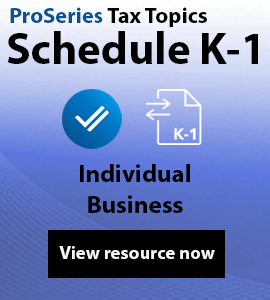- Topics
- Training
- Community
- Product Help
- Industry Discussions
- User Groups
- Discover
- Resources
- Intuit Accountants Community
- :
- ProSeries Tax
- :
- ProSeries Tax Discussions
- :
- Re: Taxable Grant?
Taxable Grant?
- Mark Topic as New
- Mark Topic as Read
- Float this Topic for Current User
- Bookmark
- Subscribe
- Printer Friendly Page
- Mark as New
- Bookmark
- Subscribe
- Permalink
- Report Inappropriate Content
I have a client who lives on 40 acres. He does some farming on it. There is a "Swell" in the land which was eroding over the past 4 years. He said it was previously a 6 foot swell and now it's 12 foot swell. The runoff is heading to a creek, which eventually makes it way into the Chesapeake Bay. He received a grant (both federal and local here in MD) for approximately $56k to put in a drainage line (600 ft) and an erosion field of 150 ft of rock to help stop the erosion.
He spent about $52k to have all the work done.
He received a 1099G box 6 "taxable grants" for $56k.
Is the $56k taxable? Since it wasn't labeled as Agriculture payments (box 7), I'm unable to link it to his SCH F. My research seems to indicate he has to pay tax on the $56k, but want to get the communities input.
Thank you!!
- Mark as New
- Bookmark
- Subscribe
- Permalink
- Report Inappropriate Content
I think you have a Swale
"A swale is a shallow, wide channel that manages water runoff on a property. Swales can be natural or man-made, and are also known as drainage ditches, bench drains, or V-ditches. "
In any case I believe it belongs on the F
I would probably enter the 1099G in other income, put an offsetting deduction as a negative on Line Z
then enter it on Schedule F as you would any other conservation expenses with a cost share offset received. (and the leftover $4000 might indeed be taxable).
I'm not an expert in Schedule F Conservation cost treatment, so this is a (slightly) educated guess, but it seems like it would get you to what might be close to a correct answer.
- Mark as New
- Bookmark
- Subscribe
- Permalink
- Report Inappropriate Content
Don't let the software tell you how to do your job. IRS might expect Box 7 amounts to show up on Schedule F, but that doesn't mean they will be surprised if Box 6 numbers are found there also. If the only way to get it on Schedule F using this city-boy software is to enter it on Box 7 of the 1099-G worksheet, so be it. The worksheet doesn't go to IRS.
Only another month until the swales return to Capistrano!
- Mark as New
- Bookmark
- Subscribe
- Permalink
- Report Inappropriate Content
I helped a client with a similar issue. His ranch was the headwaters of a drainage which included hydropower, and he got improvement grants from the State for restoring the natural landscape. Since it was not associated with the ranching operations, not related to business, it isn't ordinary and necessary expense. It's land improvement, but in his case, not a depreciable asset. Your taxpayer's change might not be permanent, though. It might have only a useful life depending on what happens to the land down the timeline.
I found this article for you, which looks useful:
https://www.calt.iastate.edu/article/tax-rules-implementing-conservation-or-climate-smart-practices
Don't yell at us; we're volunteers




